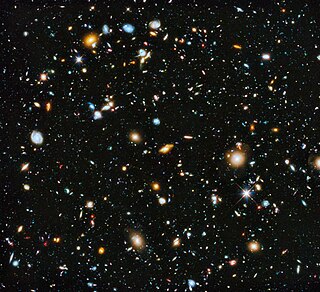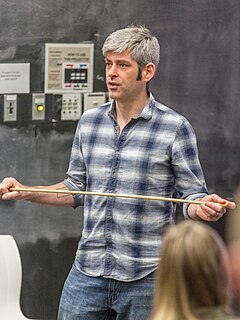Related Research Articles

The Big Bang theory is the prevailing cosmological model explaining the existence of the observable universe from the earliest known periods through its subsequent large-scale evolution. The model describes how the universe expanded from an initial state of high density and temperature, and offers a comprehensive explanation for a broad range of observed phenomena, including the abundance of light elements, the cosmic microwave background (CMB) radiation, and large-scale structure.

Physical cosmology is a branch of cosmology concerned with the study of cosmological models. A cosmological model, or simply cosmology, provides a description of the largest-scale structures and dynamics of the universe and allows study of fundamental questions about its origin, structure, evolution, and ultimate fate. Cosmology as a science originated with the Copernican principle, which implies that celestial bodies obey identical physical laws to those on Earth, and Newtonian mechanics, which first allowed those physical laws to be understood. Physical cosmology, as it is now understood, began with the development in 1915 of Albert Einstein's general theory of relativity, followed by major observational discoveries in the 1920s: first, Edwin Hubble discovered that the universe contains a huge number of external galaxies beyond the Milky Way; then, work by Vesto Slipher and others showed that the universe is expanding. These advances made it possible to speculate about the origin of the universe, and allowed the establishment of the Big Bang theory, by Georges Lemaître, as the leading cosmological model. A few researchers still advocate a handful of alternative cosmologies; however, most cosmologists agree that the Big Bang theory best explains the observations.

In physical cosmology, cosmic inflation, cosmological inflation, or just inflation, is a theory of exponential expansion of space in the early universe. The inflationary epoch lasted from 10−36 seconds after the conjectured Big Bang singularity to some time between 10−33 and 10−32 seconds after the singularity. Following the inflationary period, the universe continued to expand, but at a slower rate. The acceleration of this expansion due to dark energy began after the universe was already over 7.7 billion years old.

Dark matter is a hypothetical form of matter thought to account for approximately 85% of the matter in the universe. Its presence is implied in a variety of astrophysical observations, including gravitational effects that cannot be explained by accepted theories of gravity unless more matter is present than can be seen. For this reason, most experts think that dark matter is abundant in the universe and that it has had a strong influence on its structure and evolution. Dark matter is called dark because it does not appear to interact with the electromagnetic field, which means it does not absorb, reflect or emit electromagnetic radiation, and is therefore difficult to detect.

The universe is all of space and time and their contents, including planets, stars, galaxies, and all other forms of matter and energy. The Big Bang theory is the prevailing cosmological description of the development of the universe. According to this theory, space and time emerged together 13.787±0.020 billion years ago, and the universe has been expanding ever since. While the spatial size of the entire universe is unknown, the cosmic inflation equation indicates that it must have a minimum diameter of 23 trillion light years, and it is possible to measure the size of the observable universe, which is approximately 93 billion light-years in diameter at the present day.

Observations show that the expansion of the universe is accelerating, such that the velocity at which a distant galaxy recedes from the observer is continuously increasing with time.
The ekpyrotic universe is a cosmological model of the early universe that explains the origin of the large-scale structure of the cosmos. The model has also been incorporated in the cyclic universe theory, which proposes a complete cosmological history, both the past and future.
In cosmology and physics, cold dark matter (CDM) is a hypothetical type of dark matter. Observations indicate that approximately 85% of the matter in the universe is dark matter, with only a small fraction being the ordinary baryonic matter that composes stars, planets, and living organisms. Cold refers to the fact that the dark matter moves slowly compared to the speed of light, while dark indicates that it interacts very weakly with ordinary matter and electromagnetic radiation.

A non-standard cosmology is any physical cosmological model of the universe that was, or still is, proposed as an alternative to the then-current standard model of cosmology. The term non-standard is applied to any theory that does not conform to the scientific consensus. Because the term depends on the prevailing consensus, the meaning of the term changes over time. For example, hot dark matter would not have been considered non-standard in 1990, but would be in 2010. Conversely, a non-zero cosmological constant resulting in an accelerating universe would have been considered non-standard in 1990, but is part of the standard cosmology in 2010.

In physical cosmology, baryogenesis is the physical process that is hypothesized to have taken place during the early universe to produce baryonic asymmetry, i.e. the imbalance of matter (baryons) and antimatter (antibaryons) in the observed universe.

In physical cosmology, structure formation is the formation of galaxies, galaxy clusters and larger structures from small early density fluctuations. The universe, as is now known from observations of the cosmic microwave background radiation, began in a hot, dense, nearly uniform state approximately 13.8 billion years ago. However, looking at the night sky today, structures on all scales can be seen, from stars and planets to galaxies. On even larger scales, galaxy clusters and sheet-like structures of galaxies are separated by enormous voids containing few galaxies. Structure formation attempts to model how these structures formed by gravitational instability of small early ripples in spacetime density.

Cosmology is a branch of astronomy concerned with the study of the chronology of the universe. Physical cosmology is the study of the universe's origin, its large-scale structures and dynamics, and the ultimate fate of the universe, including the laws of science that govern these areas.

The chronology of the universe describes the history and future of the universe according to Big Bang cosmology.

In physical cosmology and astronomy, dark energy is an unknown form of energy that affects the universe on the largest scales. The first observational evidence for its existence came from measurements of supernovae, which showed that the universe does not expand at a constant rate; rather, the expansion of the universe is accelerating. Understanding the evolution of the universe requires knowledge of its starting conditions and its composition. Prior to these observations, it was thought that all forms of matter and energy in the universe would only cause the expansion to slow down over time. Measurements of the cosmic microwave background (CMB) suggest the universe began in a hot Big Bang, from which general relativity explains its evolution and the subsequent large-scale motion. Without introducing a new form of energy, there was no way to explain how an accelerating universe could be measured. Since the 1990s, dark energy has been the most accepted premise to account for the accelerated expansion. As of 2021, there are active areas of cosmology research aimed at understanding the fundamental nature of dark energy.

In cosmology, baryon acoustic oscillations (BAO) are fluctuations in the density of the visible baryonic matter of the universe, caused by acoustic density waves in the primordial plasma of the early universe. In the same way that supernovae provide a "standard candle" for astronomical observations, BAO matter clustering provides a "standard ruler" for length scale in cosmology. The length of this standard ruler is given by the maximum distance the acoustic waves could travel in the primordial plasma before the plasma cooled to the point where it became neutral atoms, which stopped the expansion of the plasma density waves, "freezing" them into place. The length of this standard ruler can be measured by looking at the large scale structure of matter using astronomical surveys. BAO measurements help cosmologists understand more about the nature of dark energy by constraining cosmological parameters.
Hylogenesis is a physical theory about the mechanism behind the origins of dark matter and antimatter. It was proposed in August 2010 in a paper by Hooman Davoudiasl, David E. Morrissey, Kris Sigurdson and Sean Tulin.

A black hole cosmology is a cosmological model in which the observable universe is the interior of a black hole. Such models were originally proposed by theoretical physicist Raj Pathria, and concurrently by mathematician I. J. Good.

Daniel Wayne Hooper is an American cosmologist and particle physicist specializing in the areas of dark matter, cosmic rays, and neutrino astrophysics. He is a Senior Scientist at Fermi National Accelerator Laboratory and an Associate Professor of Astronomy and Astrophysics at the University of Chicago.
Christopher Michael Hirata is an American cosmologist and astrophysicist.

Valery Anatolyevich Rubakov is a Russian theoretical physicist. His scientific interests include quantum field theory, elementary particle physics, and cosmology. He is affiliated with the Institute for Nuclear Research (INR) of the Russian Academy of Sciences in Moscow.
References
- ↑ Kris Sigurdson. UBC Physics & Astronomy People Directory. Retrieved on 2012-03-03.
- ↑ Listing of all Hubble Fellows Archived 2012-08-05 at archive.today . Space Telescope Science Institute. Retrieved on 2012-03-03.
- ↑ Previous People Archived 2012-02-27 at the Wayback Machine . IAS School of Natural Sciences. Retrieved on 2012-03-03.
- ↑ 2005 Commencement. California Institute of Technology. Retrieved on 2012-03-03.
- ↑ What Mass Are the Smallest Protohalos?. Physical Review Letters. Retrieved on 2012-03-03.
- ↑ Charged-Particle Decay and Suppression of Primordial Power on Small Scales. Physical Review Letters. Retrieved on 2012-03-03.
- ↑ Unified Origin for Baryonic Visible Matter and Antibaryonic Dark Matter. Physical Review Letters. Retrieved on 2012-03-03.
- ↑ X Particle Explains Dark Matter and Antimatter at the Same Time. Wired Science. Retrieved on 2012-03-03.
- ↑ How to spot a multiverse. physicsworld.com. Retrieved on 2012-03-03.
- ↑ Greene, Brian (2011). The Hidden Reality: Parallel Universes and the Deep Laws of the Cosmos . Page 166.
- ↑ Publications. Kris Sigurdson at the University of British Columbia. Retrieved on 2012-03-03.
- ↑ Hylogenesis: A Unified Origin for Baryonic Visible Matter and Antibaryonic Dark Matter. Cornell University Library. Retrieved on 2012-03-03.
- ↑ Baryon destruction by asymmetric dark matter. Physical Review D. Retrieved on 2012-03-03.